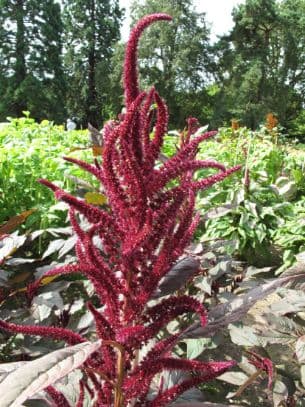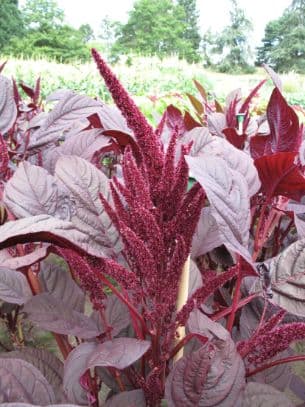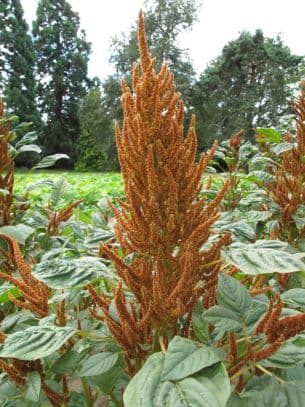Quinoa Chenopodium quinoa

ABOUT
Quinoa is a flowering plant known for its edible seeds. The plant has broad, usually powdery green leaves that are similar to those of spinach or beets, to which it is related. As the plant matures, it can produce a variety of colored flowers or inflorescences ranging from white to red or purple, often presenting in large clusters. The seeds are what make quinoa notably popular; they are small, round, and can come in multiple colors such as white, red, black, or yellow. These seeds are coated in saponins, which appear as a bitter, soapy layer that must be washed away before consumption. Overall, quinoa has a bushy, upright appearance with a profusion of seeds that hang in clusters from its green, leafy stalks.
About this plant
 Names
NamesFamily
Amaranthaceae
Synonyms
Quinoa, Inca Grain, Peruvian Rice, Quinua, Kinwa
Common names
Anserina quinoa, Chenopodium album subsp. quinoa, Chenopodium hircinum, Chenopodium nuttaliae, Chenopodium quinoa var. milleanum.
 Toxicity
ToxicityTo humans
Quinoa is generally not toxic to humans and is a popular food item known for its nutritional benefits. However, the seeds are naturally coated with saponins, which can be toxic if ingested in large quantities without proper processing. Saponins are bitter-tasting compounds that can cause mild gastrointestinal symptoms such as nausea, diarrhea, and stomach cramps if the quinoa seeds are not thoroughly rinsed before cooking. In most commercially available quinoa, the saponins have been removed. It's rare, but some individuals may have an allergic reaction to quinoa, which could lead to symptoms like itching, rashes, or difficulty breathing.
To pets
Quinoa is not typically considered toxic to pets, but as with humans, the saponins coating the seeds can cause gastrointestinal upset in some animals if not properly rinsed before ingestion. If a pet consumes raw or improperly rinsed quinoa in significant amounts, it might experience symptoms like vomiting or diarrhea. It is always best to consult with a veterinarian before incorporating new foods into your pet's diet, as individual animals can have unique sensitivities or allergies.
 Characteristics
CharacteristicsLife cycle
Annuals
Foliage type
Deciduous
Color of leaves
Green
Flower color
Varies
Height
3-9 feet (0.9-2.7 meters)
Spread
2-3 feet (0.6-0.9 meters)
Plant type
Herb
Hardiness zones
Varies
Native area
South America
Benefits
 General Benefits
General Benefits- High Nutritional Value: Quinoa is a nutritious seed that provides a high protein content with all nine essential amino acids, making it a complete protein source.
- Gluten-Free: It is naturally gluten-free, making it a suitable staple for people with celiac disease or gluten sensitivities.
- Rich in Fiber: Contains a higher amount of fiber compared to many other grains, which can aid in digestion and overall gut health.
- High in Minerals: Offers a good source of minerals like magnesium, potassium, zinc, and iron, which are vital for various bodily functions.
- Versatile Ingredient: Quinoa can be used in a variety of culinary dishes, from salads and soups to pilafs and breakfast bowls, due to its subtle nutty flavor.
- Diverse Varieties: It comes in several colors such as white, red, and black, each with its own texture and flavor profile, thereby adding diversity to meals.
- Easy to Cook: It cooks faster than many other whole grains, typically in about 15-20 minutes, making it convenient for quick meal preparation.
- Good Source of Antioxidants: Contains antioxidants like quercetin and kaempferol, which are thought to help protect against oxidative stress and reduce inflammation.
- Beneficial for Metabolic Health: The high fiber and protein content may help in managing weight and improving metabolic health by promoting a feeling of fullness and reducing calorie intake.
 Medical Properties
Medical Properties- High Nutritional Value - Quinoa is rich in vitamins and minerals, including B-vitamins, magnesium, potassium, phosphorus, and iron, supporting general wellness.
- Protein Source - It contains all essential amino acids, making it a complete protein source which may support muscle repair and growth.
- Dietary Fiber - Quinoa is high in fiber which can aid in digestive health and help maintain bowel regularity.
- Antioxidant Properties - It contains flavonoids like quercetin and kaempferol, which may possess anti-inflammatory and antiviral effects, and contribute to overall health.
- Blood Sugar Control - Its low glycemic index may help manage blood sugar levels, making it potentially beneficial for individuals with diabetes.
- Gluten-Free - Quinoa is naturally gluten-free, making it a suitable grain alternative for individuals with celiac disease or gluten intolerance.
 Air-purifying Qualities
Air-purifying QualitiesThis plant is not specifically known for air purifying qualities.
 Other Uses
Other Uses- Quinoa plant stalks can be used as building material in rural constructions due to their strength and availability after the harvest.
- The saponins found in the quinoa seeds' coating act as a natural detergent and can be used for cleaning purposes.
- Quinoa leaves, although less popular than the seeds, are edible and can be cooked similar to spinach or included in salads.
- The vibrant colors of some quinoa varieties' seeds and leaves can be utilized as a natural dye for fabrics and textiles.
- Chenopodium quinoa can be used in companion planting to attract beneficial insects and repel pests from other crops in the garden.
- Fermented quinoa can be used in the production of a beer-like beverage, which is a traditional practice in some South American regions.
- The chaff from quinoa seeds, a by-product after processing, can serve as feed for livestock or as a component in compost.
- In some communities, quinoa is cultivated as ornamental plants due to their visually appealing inflorescences.
- Quinoa seeds hulls are sometimes used as filler in low-cost pillows and insulation material for homes.
- Residues from quinoa crop processing can be employed in biogas production as a source of renewable energy.
Interesting Facts
 Feng Shui
Feng ShuiQuinoa is not used in Feng Shui practice.
 Zodiac Sign Compitability
Zodiac Sign CompitabilityQuinoa is not used in astrology practice.
 Plant Symbolism
Plant Symbolism- Nourishment - Quinoa is celebrated for its nutritional content, symbolizing the importance of physical and spiritual sustenance.
- Adaptability - As a plant that can thrive in harsh conditions, quinoa represents versatility and the ability to adapt to changing environments.
- Connection with Andean Culture - Quinoa is deeply entrenched in the traditions of the Andean people, symbolizing cultural heritage and ancestral knowledge.
- Purity - Given its status as a 'superfood' and its natural gluten-free composition, quinoa is often associated with purity and cleansing.
- Prosperity - In Andean cultures, quinoa is a symbol of prosperity due to its role as a staple crop and its contribution to economic livelihoods.
 Water
WaterQuinoa plants should be watered deeply and infrequently to mimic their native growing conditions in the Andean highlands. Initially, keep the soil evenly moist as seedlings establish but reduce frequency as plants mature. Aim to provide about one inch of water per week, either through rainfall or manual watering. During the growing season, if there isn't sufficient rain, water the quinoa plants every 5 to 7 days, ensuring that the water penetrates deeply into the root zone. Avoid overhead watering to prevent fungal diseases and do not water quinoa too late in the day to allow foliage to dry before nightfall.
 Light
LightQuinoa thrives best in full sunlight conditions, preferring a spot where it can receive at least six hours of direct sun daily. These plants are adapted to bright, intense light, typical of their native high-altitude habitat. For optimal growth, ensure that quinoa is planted in an area with unobstructed exposure to sunlight throughout the day.
 Temperature
TemperatureQuinoa plants are hardy and can tolerate a temperature range from about 35°F to 95°F. However, the ideal temperature for growing quinoa falls between 60°F and 75°F. Night temperatures should not drop below 35°F, as frost can damage the plants, whereas temperatures consistently above 95°F can stress the plant and affect seed development.
 Pruning
PruningPruning is not typically required for quinoa plants, as they are grown primarily for their seeds rather than foliage or form. However, if necessary to improve air circulation or remove damaged leaves, pruning can be performed during the growing season. The best time for any necessary pruning would be during a dry day to prevent the spread of disease.
 Cleaning
CleaningNot needed
 Soil
SoilQuinoa prefers well-draining soil with a pH of 6.0 to 7.5. A mix of loamy soil enriched with compost is ideal to provide the necessary nutrients.
 Repotting
RepottingQuinoa, typically grown as an annual, does not require repotting as it is harvested at the end of the growing season.
 Humidity & Misting
Humidity & MistingQuinoa is quite adaptable but prefers moderate humidity levels; it does not require high humidity environments.
 Suitable locations
Suitable locationsIndoor
Quinoa needs full sun, so place near a sunny window.
Outdoor
Plant in full sun, space seeds 1 ft apart.
Hardiness zone
4-10 USDA.
 Life cycle
Life cycleThe lifecycle of quinoa (Chenopodium quinoa) begins with seed germination, which occurs when soil temperatures reach around 5 degrees Celsius (41 degrees Fahrenheit); seeds sprout within 4 to 5 days if moisture is adequate. After germination, the seedlings establish themselves with a strong taproot and begin vegetative growth, rapidly developing leaves and stems. The vegetative phase lasts until environmental conditions trigger flowering, often initiated by long days during the growing season, where the plant forms clusters of small, self-pollinating flowers. Following pollination, quinoa sets seeds encased in a protective fruit called an achene; the flowering to seed maturity stage can take from 70 to 120 days depending on the variety and climate conditions. Mature quinoa plants exhibit a range of colors from white or green to red or black as they set seeds, which are ready for harvest when the leaves fall off and the plants turn a straw-like color. After harvest, the plant lifecycle can continue as new seeds are either collected and sown for the next crop or naturally fall to the ground and potentially germinate to start the process anew if conditions are favorable.
 Propogation
PropogationPropogation time
Spring-Early Summer
Propogation: Quinoa is predominantly propagated through seeds, which is also the most popular method of propagation for this crop. The best time to sow quinoa seeds is in early spring, once the soil has thawed and there is no longer a risk of frost, as quinoa is quite tolerant to cold but not to frosts that occur after planting. Seeds should be sown directly into well-drained soil at a depth of about a quarter inch to half an inch (about 6 to 13 millimeters). Row spacing is generally around 14 to 18 inches (35 to 45 centimeters), allowing for easier cultivation and airflow between plants. Watering should be consistent to keep the soil moist until germination, which typically occurs within 4 to 10 days. As the plants grow, thinning might be necessary to maintain a spacing of 10 to 14 inches (25 to 35 centimeters) between plants to ensure adequate airflow and reduce the risk of fungal diseases. Quinoa plants are generally ready for harvest 90 to 120 days after seed sowing, depending on the variety and weather conditions.









